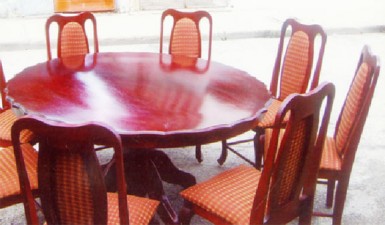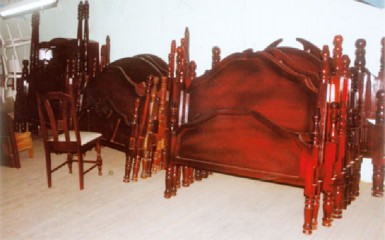Shaan Khan has nothing but a scowl for a society, which he feels has more or less lost its appreciation for classy drawing rooms and tastily furnished bedrooms. He could go on forever about the local demand during the twentieth century for fine drawing-room furniture, chairs, tables, stools, plant stands, cabinets and huge wooden beds and bedside tables and cupboards fashioned from carefully prepared hardwoods, first, as separate pieces then eventually fitted and glued together.
Those were the days, he says, when the joiner brought his works of art to the homes of the middle class and when even “the poorer class” sought to afford some pieces.
In the halcyon days of joinery, Khan had been apprenticed to Mohan Persaud’s Furniture Store on Saffon Street. That was after he had been introduced to “working with wood” at Carmel Primary School. After that, he worked with the establishment helping to turn out furniture to supply Guyana Stores, Fogarty’s and several of the other furniture stores in the city.
He later branched out on his own, supplying stores himself. To this day he still supplies Ramroop’s Furniture Store, one of the best-known establishments of its kind in Georgetown.
An openly brooding Khan bemoans the decline in the trade, that has reduced demand and the loss of interest amongst young men in cultivating the skills associated with joinery. He talks too, about the rise of the foam-filled settee and the flat pack furniture made of wood that swells and collapses when water is deposited on it.
Some of the choice pieces of joinery from decades ago still survive. Some are still attractive but too worn to serve their substantive purposes, so that these days they are simply left for visitors to admire. Other pieces soldier on with the assistance of a joiner who provides seasonal rehabilitation, including sanding and polishing.

It is, Khan says, a far cry from the furniture fashioned mostly from MDF (Modern Density Fibreboard), a dry, processed board manufactured from wood fibres. Short-term attractiveness is outweighed by its notorious lack of durability.
The essence of joinery reposes, first in the selection then the cutting and fitting of the components together without the use of nails, screws and other metal fasteners. The creation of the joints require both the use of machinery and eventually a delicate process of sanding before the joints are fixed then glued together.
The current housing drive has enhanced the demand for joiners in the production of interior and exterior doors, windows, stairs, and in fewer cases, bookshelves. Still, Khan says, joinery is not what it used to be.
At his workshop, Khan talks about the craft as though he is presiding at its requiem. Amongst those who can afford it he detects a preference for “exotic” imported furniture or the upholstered pieces that appear to dominate the market.
Thirty years may be a relatively short time but Khan believes that he has witnessed a definitive transformation in the trade. The reasons are manifold. While joinery continues to account for relatively small quantities of Guyana’s hardwoods, popular demand in the building trade and the requirements of the external market mean that good wood has become scarcer, more costly. Equally pertinent is the fact that joinery has attracted far fewer apprentices, the more popular pursuit of carpentry being more straightforward and much more in demand. The extent of the interest of Khan’s two sons in joinery goes no further than helping their father out. He notes too that the school system appears to pay less attention to woodwork-related skills as part of the curriculum these days.
Khan says that while a number of persons present themselves as joiners that turns out, frequently, not to be the case. “They may be good carpenters but put to the test and they cannot perform,” he says.
Khan loathes the attitude of the modern-day apprentices. Many of them, he says, are unreliable. “Some of them show up for a few days then disappear,” he says. Advertising doesn’t help. These days he has no full time employees. He recruits as the need arises; after the particular need passes they leave.
At his establishment, Modern Furniture and Joinery Establishment situated at 24 Hill and James streets in Albouystown, Khan talks about the quality of wood on the market. Much of the best hardwood goes to the highest bidder and while joinery requires high quality hardwood, joiners are usually not the highest bidders.
Due to the high price of wood he was forced to stop making doors. Still, he manages to keep his prices below those that obtain on the high street. A modest clothing closet can be bought for around $18,000 and kitchen cupboards cost $30,000. Furniture is ordered and once there is agreement on the exact nature of the request a price is set.
Khan recalls that when he started in the industry several years ago joiners were much more a part of the process of selecting the wood they used. “That way you got quality wood. People used to be able to identify the mature wood,” he says. The two sectors – forestry and joinery – don’t work that way anymore.
Khan said some of the best woods for furniture are cedar, crab wood and silverballi, though these can fetch high and sometimes wildly fluctuating prices.
Time was when he visited homes to render (polish and renovate) furniture created by joiners. These days, this Albouystown businessman spends most of his time creating and repairing the more commonly used furniture. He has had to bow to the pressures of changing tastes.

His key market these days is the working class family seeking to acquire pieces of furniture, perhaps one piece at a time. He retains the traditional ‘balance parcel’ system that allows for modest payments over relatively long periods.
Contemporary high street department stores pose their own challenges for small furniture establishments while the increasing popularization of hire purchase payments has seen a shift to bigger stores that offer a greater range of items. Khan’s operation is much too small to significantly affect the broader situation.
He persists, pointing out that his busy period is the weeks between October and December. During that period there is a higher number of orders for the types of furniture that allows him to put his skills as a joiner to work. During that period there is a greater inflow of funds so that at least the bills are paid while he waits for the resurgence of the trade to which he has given all of his working life.
There was a time, Khan says, when he exported furniture to Trinidad and Tobago through an agent. He lost that market to a glut. For a while, too, he operated a store on the East Bank Demerara until the rented building was repossessed. He wants to open an outlet outside of Albouystown but high rental costs and potential difficulties in recruiting workers are the main disincentives.





